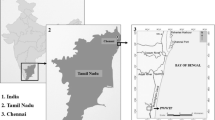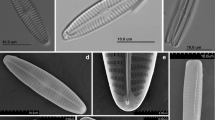Abstract
Experiments were conducted to develop a sensitive sublethal toxicity test protocol to determine the toxicity of municipal wastewater effluents to larvae of the red abalone Haliotis rufescens. In multiple tests, fertilized abalone embryos were exposed for 48 h to dilutions of a reference toxicant, zinc sulfate, and to dilutions of primary-and secondary-treated effluents. The resulting veliger larvae were examined microscopically for larval shell abnormalities. In a longer flowthrough experiment, abalone were exposed for the entire larval phase, from the two-cell stage through metamorphosis, to compare zinc effects on metamorphosis with zinc effects on short-term larval shell development. Dissolved oxygen, pH, salinity and temperature were measured daily in test solutions, and zinc concentrations were verified by chemical analysis. “No observed effect concentrations” (NOECs) for zinc were 39±2.1 μg l-1 in three 48 h exposures, and 19 μg l-1 for the 9 d exposure through metamorphosis. Median effect concentrations (EC50s) were 68±6.9 μg l-1 in 48 h tests and 50 μg l-1 in the 9 d test. Abalone larvae were affected at lower concentrations of primary than of secondary effluent.
Similar content being viewed by others
Literature cited
Alexander, G. V., Young, D. R. (1976). Trace metals in southern California mussels. Mar. Pollut. Bull. 7: 7–9
American Public Health Association (1985). Standard methods for the examination of water and wastewater. APHA, Washington, D.C.
Baloun, A. J., Morse, D.E. (1984). Ionic control of settlement and metamorphosis in larval Haliotis rufescens (Gastropoda). Biol. Bull. mar. biol. Lab., Woods Hole 167: 124–138
Brown, D. A., Gossett, R. W., Hershelman, H. A., Schafer, H. A., Jenkins, K. D., Perkins, E. M. (1983). Bioaccumulation and detoxification of contaminants in marine organisms from southern California coastal waters. In: Soule, D. F., Walsh, D. (eds.) Waste disposal in the oceans: minimizing impact, maximizing benefits, Westview Press, Boulder, Colorado, p. 171–193
Bruland, K. W., Knauer, G. A., Martin, J. H. (1978). Zinc in northeast Pacific seawater. Nature, Lond. 271: 741–743
Brungs, D., Lemke, A. E. (1978). Manual for construction and operation of toxicity testing proportional diluters. Environmental Research Laboratory, U.S. EPA, Duluth, Minnesota (PB-287-606-8BE)
Calabrese, A., Collier, R. S., Nelson, D. A., MacInnes, J. R. (1973). The toxicity of heavy metals to embryos of the American oyster Crassostrea virginica. Mar. Biol. 18: 162–166
Crofts, D. R. (1937). The development of Haliotis tuberculata, with special reference to organogenesis during torsion. Phil. Trans. R. Soc. (Ser. B) 228: 219–268
Cross, J. N. (1988). Fin erosion and epidermal tumors in demersal fish from southern California. In: Wolfe, D. A., O'Connor, T. P. (eds.) Oceanic processes in marine pollution. Vol. 5. Urban wastes in coastal marine environments. R. E. Krieger Publ. Co., Inc., Malabar, Florida, p. 57–64
Cross, J. N., Hose, J. E. (1988). Evidence for impaired reproduction in white croaker (Genyonemus lineatus) from contaminated areas off southern California. Mar. envirl Res. 24: 185–188
Dimick, R. E., Breese, W. P. (1965). Bay mussel embryo bioassay. Proc. 12th Pacif. NW. ind. Waste Conf. 165–175
Dinnel, P. A., Link, J. M., Stober, Q. J. (1987). Improved methodology for a sea urchin sperm cell bioassay for marine waters. Archs envir. Contam. Toxic. 16: 23–32
Ebert, E. E., Houk, J. L. (1984). Elements and innovations in the cultivation of red abalone Haliotis rufescens. Aquaculture, Amsterdam 39: 375–392
Gentile, S. M., Gentile, J. H., Walker, J., Heltshe, J. F. (1982). Chronic effects of cadmium on two species of mysid shrimp: Mysidopsis bahia and Mysidopsis bigelowi Hydrobiologia 93: 195–204
Glass, G. V., Peckham, P. D., Sanders, J. R. (1972). Consequences of failure to meet assumptions underlying the fixed effects analyses of variance and covariance. Rev. Educ. Res. 42: 237–288
Grigg, R. W., Kiwala, R. S. (1970). Some ecological effects of discharged wastes on marine life. Calif. Fish Game 56: 145–155
Hennig, H. F.-K. O., Greenwood, P. J. (1981). The loss of cadmium and zinc from seawater during accumulation experiments: its implication on toxicity threshold concentrations. Mar. Pollut. Bull. 12: 47–50
Kuwabara, J. S. (1982). Micronutrients and kelp cultures: evidence for cobalt and manganese deficiency in southern California deep seawater. Science, N.Y. 216: 1219–1221
Livingston, R. J., Koenig, C.C., Lincer, J. L., McAuliffe, C.D., Michael, A., Nadeau, R. J., Sparks, R. E., Vaughn, B. E. (1974). Synergism and modifying effects: interacting factors in bioassay and field research. In: Cox, G. (covenor) Proceedings of a Workshop on Marine Bioassays, Long Island, N.Y., Marine Technological Society, Washington, D.C.
Lussier, S. M., Gentile, J. H., Walker, J. (1985). Acute and chronic effects of heavy metals and cyanide on Mysidopsis bahia. Aquat. Toxic. 7: 25–35
Martin, M., Osborn, K. E., Billing, P., Glickstein, N. (1981). Toxicities of ten metals to Crassostrea gigas and Mytilus edulis embryos and Cancer magister larvae. Mar. Pollut. Bull. 12: 305–308
Martin, M., Stephenson, M. D., Martin, J. H. (1977). Copper toxicity experiments in relation to abalone deaths observed in a power plant's cooling waters. Calif. Fish Game 63: 95–100
Morse, D. E., Duncan, H., Hooker, N., Morse, A. (1977). Hydrogen peroxide induces spawning in molluscs, with activation of prostaglandin endoperoxide synthetase. Science, N.Y. 196: 298–300
Morse, D. E., Hooker, N., Duncan, H., Jensen, L. (1979). Gamma aminobutyric acid, a neurotrasmitter, induces planktonic abalone larvae to settle and begin metamorphosis. Science N.Y. 204: 409–410
Muramoto, S. (1981). Vertebral column damage and decrease of calcium concentration in fish exposed experimentally to cadmium. Envir. Pollut. (Ser. A) 24: 125–133
Peltier, W. H., Weber, C. I. (1985). Methods for measuring the acute toxicity of effluents to freshwater and marine organisms. 3rd. ed. U.S. Environmental Protection Agency Cincinnati, Ohio (Rep. No. EPA/600/4-85/013)
Petering, H. G., Johnson, M. A., Slemmer, K. O. (1971). Studies of zinc metabolism in the rat. Archs envir. Hlth 23: 93–101
Reish, D. J. (1978). The effects of heavy metals on polychaetous annelids. Revue int. Océanogr. méd. 49: 99–104
Schafer, H. A. (1984). Characteristics of municipal wastewater, 1982–1983. In: Bascom, W. (ed.) Southern California Coastal Water Research Project Biennial Report, 1983–1984. California Coastal Water Research Project, Long Beach, California p. 11–19
Swartz, R. C., Cole, F. A., Schultz, D. W., DeBen, W. A. (1986). Ecological changes in the southern California Bight near a large sewage outfall: benthic conditions in 1980 and 1983. Mar. Ecol. Prog. Ser. 31: 1–13
Seki, T., Kan-no, H. (1981). Induced settlement of the Japanese abalone, Haliotis discus hannai, veliger by the mucous trails of the juvenile and adult abalone. Bull. Tohoku reg. Fish. Res. Lab. 43: 29–36
Sokal, R. R., Rohlf, F. J. (1981). Biometry. The principles and practice of statistics in biological research, 2nd ed. W. H. Freeman & Co. San Francisco
Sprague, J. B., McLeese, D. W. (1968). Toxicity of kraft pulp mill effluent for larval and adult lobsters, and juvenile salmon. Wat. Res. 2: 753–760
Strömgren, T. (1982). Effect of heavy metals (Zn, Hg, Cu, Cd, Pb, Ni) on the growth of Mytilus edulis. Mar. Biol. 72: 69–72
Theede, H. (1980). Physiological responses of estuarine animals to cadmium pollution. Helgoländer wiss. Meeresunters 33: 26–35
Woelke, C. E. (1972). Development of a receiving water quality bioassay criterion based on the 48-hour Pacific oyster (Crassostrea gigas) embryo. Tech. Rep. Wash. Dept Fish. 9: 1–93
Young, D. R., Moore, M. D., Jan, T. K., Eganhouse, R. P. (1978). Metals in seafood organisms near a large California municipal outfall. Mar. Pollut. Bull. 12: 134–138
Young, P. H. (1964). Some effects of sewer effluent on marine life. Calif. Fish Game 50: 33–41
Author information
Authors and Affiliations
Additional information
Communicated by P. C. Schroeder, Pullman
Rights and permissions
About this article
Cite this article
Hunt, J.W., Anderson, B.S. Sublethal effects of zinc and municipal effluents on larvae of the red abalone Haliotis rufescens . Mar. Biol. 101, 545–552 (1989). https://doi.org/10.1007/BF00541657
Accepted:
Issue Date:
DOI: https://doi.org/10.1007/BF00541657




